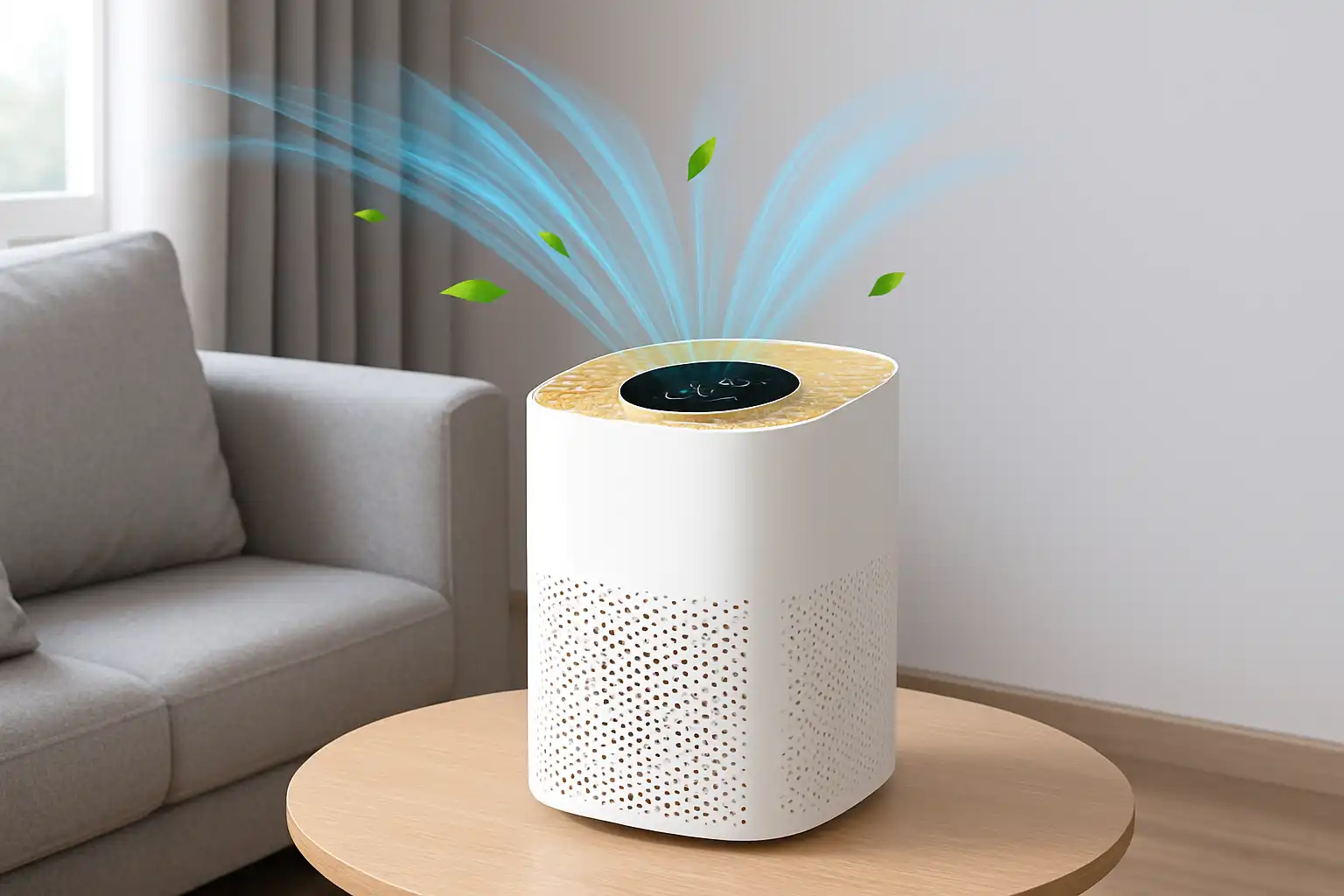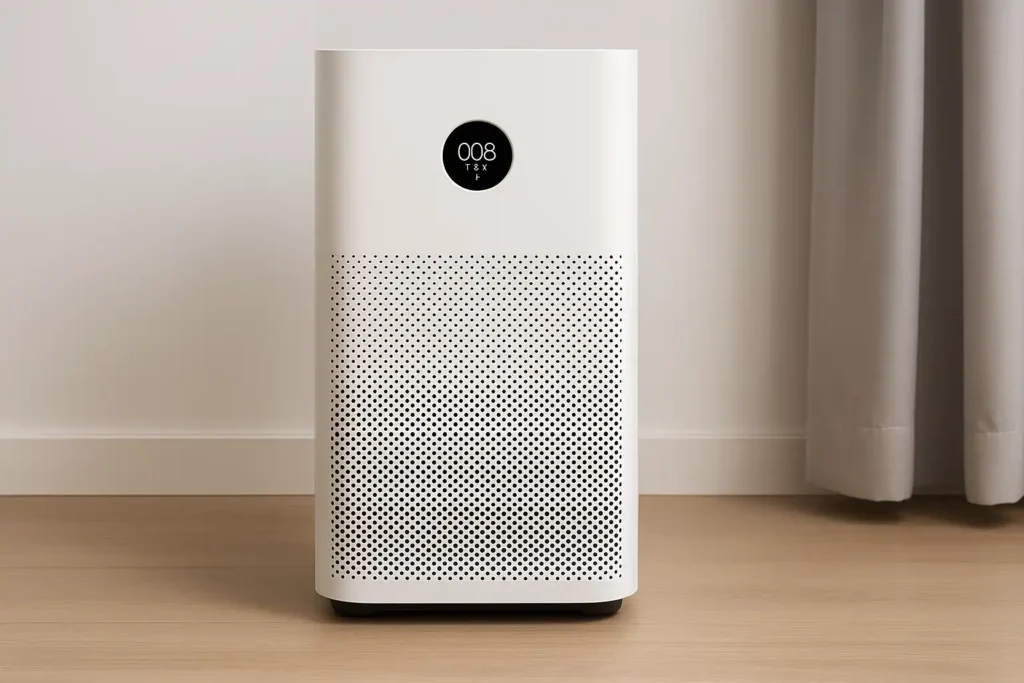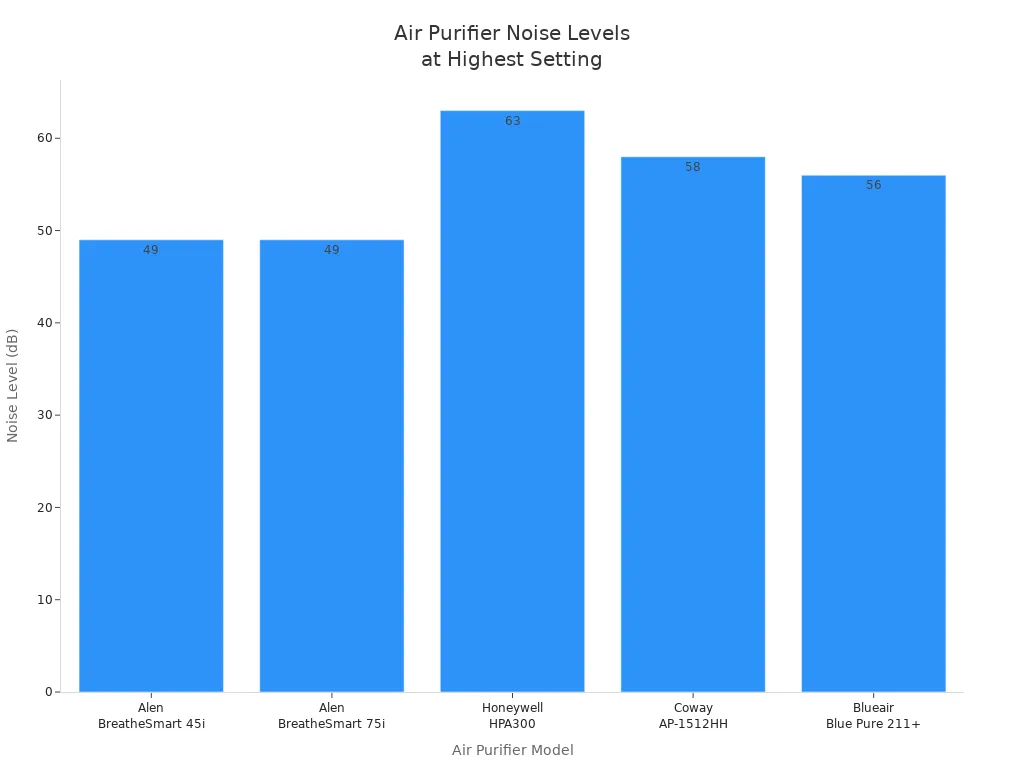
An air purifier is a machine that helps you breathe better air. It takes away bad particles and gases from the air inside your home. Many people in the United States use air purifiers to make their air cleaner.
| Household Type / Condition | Percentage Using Air Purifiers |
|---|---|
| U.S. adults owning an air purifier (2022) | 52% |
| Two-parent homes | 46% |
| Single-parent homes | 3% |
| Families with indoor breathing issues | 27% |
You might have these things in your home:
- Biological pollutants like animal dander, dust mites, mold, and dust
- Pesticides from insecticides and gases
- Tobacco smoke with harmful chemicals
- Volatile Organic Compounds (VOCs) from everyday products
Key Takeaways
- Air purifiers help clean the air inside your home. They take out dust, pollen, smoke, and some germs. This helps you breathe better and stay healthy.
- HEPA filters catch small things like dust and allergens. Activated carbon filters get rid of bad smells and harmful gases. This makes the air better to breathe.
- Pick an air purifier with the right Clean Air Delivery Rate (CADR). Make sure it matches your room size. This helps clean the air well.
- Change and clean the filters often. This keeps your air purifier working right. It also stops bad smells and weak air flow.
- Put your air purifier in a room you use a lot. Leave space around it. Do not use ionizers if you worry about ozone safety.
Air Purifier Basics

What Is an Air Purifier
An air purifier is a device that helps clean the air. It takes in air from your room and removes things like dust, pollen, and smoke. It can also catch some germs. After that, it sends out cleaner air for you to breathe. Some air purifiers use special filters. Others use different ways to catch or break down bad stuff in the air. Your room may smell better and feel fresher when you use one.
Tip: Put your air purifier in the room you use most. This way, you get the best results for your health and comfort.
Main Uses
People use air purifiers in many places to make air better. Homes often have them, especially if someone has allergies or asthma. They help lower dust, pet dander, and bad smells. Offices and workplaces use them to help workers stay healthy and focused.
Classrooms are also good places for air purifiers. A study in Finland found that using portable air cleaners with HEPA or EPA filters in primary schools made the air safer. Students could breathe easier and had fewer breathing problems. Air purifiers work well in any indoor space where people spend a lot of time and want clean air.
Other common uses are:
- Cutting down smoke from cooking or tobacco
- Getting rid of strong smells from cleaning products
- Lowering pollen during allergy season
How Air Purifiers Work

Filtration Principle
An air purifier acts like a smart filter for your room. It uses different ways to catch or remove things you do not want in the air. The main ways are mechanical filtration, adsorption, and catalytic oxidation.
| Method | Mechanism | Target Pollutants | Key Characteristics and Limitations |
|---|---|---|---|
| Mechanical Filtration | Physically traps particles using filters (like HEPA) | Dust, pollen, smoke, mold spores | Captures particles ≥0.3 microns with high efficiency. Needs regular filter changes. Not effective for gases or VOCs. |
| Adsorption | Uses activated carbon with tiny pores to capture molecules | Gases, odors, VOCs | Removes gases at the molecular level. Not for particles. Increases air resistance, so fan power matters. |
| Catalytic Oxidation | Breaks down organic pollutants using catalysts and UV light | VOCs, bacteria, viruses, mold | Destroys pollutants chemically. Can handle microbes and VOCs. More complex and often more expensive. |
Mechanical filtration is used most often. HEPA filters are special because they trap almost all particles that are 0.3 microns or bigger. Medical-grade HEPA filters, like H13 and H14, work even better. They can remove almost every tiny particle. Health experts say these filters are best for hospitals and places that need very clean air. Some advanced filters, such as HyperHEPA, can even catch super tiny particles. Activated carbon filters help by taking away smells and gases, but they do not catch dust or pollen.
Motor and Fan Role
The motor and fan inside an air purifier are important for cleaning air. The fan pulls air from your room and pushes it through the filters. The speed and power of the fan decide how much air goes through each minute. This is called the Clean Air Delivery Rate (CADR).
A higher fan speed means more air gets cleaned faster. If you use a thicker filter, the fan has to work harder. If the fan is weak, less air moves through, and the room does not get as clean. The best results happen when the fan matches the filter. Most home air purifiers have a CADR between 130 and 260 cubic feet per minute (cfm). This works well for most rooms.
| Room Area (sq ft) | 100 | 200 | 300 | 400 | 500 | 600 |
|---|---|---|---|---|---|---|
| Minimum CADR (cfm) | 65 | 130 | 195 | 260 | 325 | 390 |
Tip: For best results, pick an air purifier with a CADR that is at least two-thirds of your room’s size.
Sieve Effect
The sieve effect is one way filters catch particles. When air moves through the filter, big particles get stuck. This is like how a kitchen strainer catches pasta but lets water go through. The sieve effect works best for bigger things.
But filters do more than just act like a sieve. They use other ways to catch smaller particles too. Here are the main ways filters trap particles:
| Filtration Mechanism | Description |
|---|---|
| Straining (Sieve Effect) | Captures particles larger than the filter openings by blocking them based on size. |
| Inertial Impaction | Uses particle inertia to separate particles when air changes direction, causing them to hit filter fibers. |
| Interception | Particles follow air flow and stick to fibers when they touch them. |
| Diffusion | Very small particles move randomly and bump into fibers, making it easier to catch them. |
| Electrostatic Attraction | Charged particles stick to oppositely charged plates or fibers, trapping fine dust and smoke. |
The sieve effect helps remove large dust and pollen. Smaller things, like smoke or germs, get trapped by diffusion, interception, or electrostatic attraction. Using all these ways together makes air purifiers very good at cleaning the air in your home.
Air Purifier Technologies
HEPA Filters
HEPA filters are a trusted way to clean air at home. Many air purifiers use these filters. They trap tiny particles when air moves through thick fibers. HEPA means High-Efficiency Particulate Air. These filters can catch almost all dust, pollen, mold, and some bacteria.
| Aspect | Detail |
|---|---|
| Minimum Efficiency | 99.97% removal of particles as small as 0.3 microns |
| Application | Cleanrooms, hospitals, and sensitive environments |
| Standard Source | U.S. Department of Energy (DOE) |
HEPA filters catch most things floating in the air. They do not get rid of gases or smells. You might need another filter for those.
Note: Change HEPA filters often so they keep working well.
Activated Carbon
Activated carbon filters use a special kind of carbon. This carbon has lots of tiny holes. The holes trap gases and bad smells from the air. Air purifiers with this filter help remove odors and chemical fumes. Activated carbon works best for getting rid of VOCs, hydrogen sulfide, and other gases. VOCs come from cleaners, paint, and new furniture.
A study from MIT says activated carbon filters are safer and work better for VOCs than chemical oxidation. They do not make harmful leftovers. This makes them a good choice for homes.
Ionizers and Electrostatic
Ionizers and electrostatic precipitators use electricity to clean air. Ionizers send out charged ions. These ions stick to dust and pollen in the air. The particles get heavy and fall on surfaces. You need to wipe these surfaces to get rid of the dust.
Electrostatic precipitators pull air inside. They charge the particles and collect them on plates. This traps dust and pollen inside the machine.
⚠️ Caution: Ionizers can make ozone, which can hurt your lungs. Ozone can cause breathing problems. This is worse for kids, older people, and people with asthma. Health experts say to use other air cleaning methods if you worry about ozone.
Catalytic Oxidation
Catalytic oxidation, also called photocatalytic oxidation (PCO), uses a special catalyst and UV light. When air goes through, the catalyst and UV light make strong cleaning agents. These agents break down VOCs and germs into water vapor and carbon dioxide. This helps remove chemical fumes and some germs from the air.
You find catalytic oxidation in some advanced air purifiers. It works well for breaking down VOCs. Some models may make small amounts of byproducts. Always check the product details before you buy this type.
Benefits and Effectiveness
Health and Allergies
Air purifiers can help people with allergies and asthma. Many studies show that HEPA filters make allergy symptoms better. People feel healthier and need less medicine. One study found adults with allergic rhinitis had fewer problems. They also used less medicine when they used an air purifier. Air purifiers lower PM2.5 and PM10 levels. These are tiny particles that make allergies worse. Bedrooms often have more PM than living rooms. Putting an air purifier in your bedroom can help you breathe easier.
Here is a table showing what researchers found about air purifiers and allergies:
| Study / Author(s) | Population / Setting | Outcomes / Findings |
|---|---|---|
| Morgan et al. (2004) | 937 children with atopic asthma | Fewer asthma symptoms; effect similar to inhaled medicine. |
| Sulser et al. (2009) | Children with pet allergy | Fewer night asthma symptoms; better breathing. |
| Stillerman et al. (2010) | Allergic rhinitis patients | Lower particle counts; better symptoms and quality of life. |
| Francis et al. | Adults with asthma and indoor pets | Improved asthma outcomes; less need for treatment. |
You can see that air purifiers help people with allergies and asthma. They feel better and use less medicine.
Odor and Smoke
Air purifiers take away smoke and some smells from your home. HEPA filters trap almost all smoke particles that are 0.3 microns or bigger. Studies show portable air filters can cut smoke in homes by about 60%. This helps protect your lungs and heart. It is extra helpful for kids and older adults.
- HEPA filters catch smoke and dust, so air is cleaner.
- Activated carbon filters help with smells, but most do not remove all gases.
- Air purifiers lower fine particles in the air, so you breathe better.
Tip: For best results, use an air purifier and open windows. Do not smoke inside.
Limitations
Air purifiers cannot fix every air problem. Some do not remove very tiny particles or all gases like formaldehyde. The Clean Air Delivery Rate (CADR) may not show how well it works in big rooms. Filters stop working well over time, so you must change them. Some types, like ionizers, can make ozone, which is bad for your lungs. Noise and energy use can also make you use your air purifier less.
- Air purifiers do not lower humidity.
- They do not remove all harmful gases or chemicals.
- Some types may make ozone as a byproduct.
- You still need to stop pollution, like smoking or mold.
Note: Pick an air purifier with the right filter for you. Check for safety labels.
Choosing and Maintaining
Key Features
When you choose an air cleaner for your space, you want to match its power to your room size. Measure your room’s length, width, and ceiling height. Multiply these numbers to get the cubic volume. Rooms with high ceilings need more cleaning power. For example, if your ceiling is above 9 feet, you should increase the purifier’s capacity by 15-20%.
You should also check the Clean Air Delivery Rate (CADR). This number tells you how fast the machine can clean the air. For a small room up to 250 square feet, a model like the Blue Pure 411i Max with a CADR of 112 CFM works well. For medium rooms, the DustMagnet™ 5440i with a CADR of 255 CFM is a good choice. Large rooms up to 1100 square feet need a stronger model, such as the Blue Pure 311i+ Max with a CADR of 300 CFM.
Noise level matters, especially if you use the device in a bedroom or office. Some models, like the Alen BreatheSmart 45i, run as quietly as 23 decibels on the lowest setting. Others, like the Honeywell HPA300, can reach 63 decibels at the highest speed.
| Air Purifier Model | Noise Level (dB) Lowest Setting | Noise Level (dB) Highest Setting |
|---|---|---|
| Alen BreatheSmart 45i | 23 | 49 |
| Alen BreatheSmart 75i | 42 | 49 |
| Honeywell HPA300 | N/A | 63 |
| Coway AP-1512HH | N/A | 58 |
| Blueair Blue Pure 211+ | N/A | 56 |

You may want extra features like adjustable fan speeds, remote control, or a design that fits your room. Choose filters based on your needs: HEPA for dust and pollen, carbon for odors, and special filters for smoke or chemicals.
Maintenance Tips
To keep your device working well, you need to follow a regular maintenance schedule. Replace main filters, such as HEPA, every 6 to 12 months. Change activated carbon filters every 3 to 6 months. Clean pre-filters with a vacuum every 1 to 3 months. This helps protect the main filter and keeps the machine running smoothly.
| Filter Type | Recommended Replacement Interval |
|---|---|
| HEPA Filter (Non-Sealed) | Every 6 to 12 months |
| True HEPA Filter (Sealed) | Every 2 to 5 years |
| Activated Carbon Filter | Every 2 to 5 years |
| Carbon Foam Filter | Every 6 to 12 months |
| Pre & Post Filters | Every 6 to 12 months |
You should also plan for yearly costs. Most people spend $25 to $250 each year on filter changes and cleaning. Flat filters cost $5 to $25, while pleated filters can cost $30 to $125. If you need repairs, labor can cost $100 to $250 per hour plus parts. Electricity use adds a small amount to your bill.
Tip: Set reminders for filter changes and cleaning. This keeps your air cleaner running at its best and helps you avoid expensive repairs.
You can make your indoor air better by picking the right cleaning tool. HEPA filters catch almost all dust and things that cause allergies. Activated carbon takes away bad smells and gases. If you use your air purifier often, you will breathe easier and feel better. Cleaner air means you have fewer allergy and breathing problems. Put your air purifier in a good spot and change the filter often to keep it working well.
- Clean air helps you have less trouble with allergies and breathing.
- Put your air purifier in a good place and change filters often.
| Tip | How to Maximize Clean Air |
|---|---|
| Placement | Leave 3-5 feet of space around your air purifier |
| Maintenance | Change filters when needed and clean the vents |
| Room Match | Pick the right size air purifier for your room |
Pick a model that works for you and take care of it to get the best clean air.
FAQ
What does a HEPA filter remove from the air?
A HEPA filter removes dust, pollen, mold spores, pet dander, and some bacteria. You can trust it to catch almost all particles that are 0.3 microns or larger. It does not remove gases or odors.
What size air purifier do you need for your room?
You need to match the air purifier’s Clean Air Delivery Rate (CADR) to your room size. Measure your room in square feet. Choose a purifier with a CADR that is at least two-thirds of your room’s area.
What happens if you do not change the filter?
If you do not change the filter, your air purifier will not work well. Dirty filters block airflow and let more dust and allergens stay in your air. You may also notice bad smells.
What is the difference between HEPA and activated carbon filters?
HEPA filters trap solid particles like dust and pollen. Activated carbon filters remove gases and odors. You often need both types for the best air cleaning in your home.
What should you avoid when using an air purifier?
You should avoid blocking the air intake or placing the purifier in a corner. Do not use ionizers if you worry about ozone. Always follow the manufacturer’s instructions for safe and effective use.
